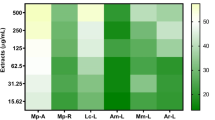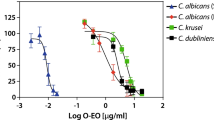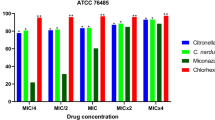Abstract
The inhibitory effect of 30 plant oils was evaluated against biofilm forming Candida albicans strain (CA I) isolated from clinical samples, which was sensitive to 4 µg/ml of fluconazole, used as a positive control. The standard strain (MTCC 227, CA II) used in this study was found to be highly resistant to fluconazole, 3,000 µg/ml of which was required to inhibit the growth of this strain partially, and complete inhibition could not be achieved. Eighteen among the 30 plant oils tested were found to show anti-Candida activity by disc diffusion assay. Effective plant oils were assessed using XTT (2, 3-bis [2-Methoxy-4-nitro-5-sulphophenyl]-2H-tetrazolium-5-carboxanilide) reduction assay for biofilm quantification. Four oils eucalyptus, peppermint, ginger grass and clove showed 80.87%, 74.16%, 40.46% and 28.57% biofilm reduction respectively. Minimum inhibitory concentration (MIC) values were calculated using agar dilution assay. Scanning electron microscopic (SEM) analysis further revealed reduction in C. albicans biofilm in response to effective oils. The substantial antifungal activity shown by these plant oils suggests their potential against infections caused by C. albicans.
Similar content being viewed by others
References
Ramage G, Saville SP, Thomas DP, Lopez-Ribot JL. Candida biofilms: an update. Eukaryot Cell 2005;4(4): 633–8.
Jain N, Kohli R, Cook E, Gialanella P, Chang T, Fries BC. Biofilm formation by and antifungal susceptibility of Candida isolates from urine. Appl Environ Microbiol 2007;73(6):1697–703.
Meyer B. Approaches to prevention, removal and killing of biofilms. Int Biodeter Biodegr 2003;51:249–53.
Sheehan DJ, Hitchcock CA, Sibley CM. Current and emerging azole antifungal agents. Clin Microbiol Rev 1999;12(1):40–79.
Bruzual I, Riggle P, Hadley S, Kumamoto CA. Biofilm formation by fluconazole-resistant Candida albicans strains is inhibited by fluconazole. J Antimicrob Chemother 2007;59:441–50.
Sanglard D, Ischer F, Parkinson T, Falconer D, Bille J. Candida albicans mutations in the ergosterol biosynthetic pathway and resistance to several antifungal agents. Antimicrob Agents Chemother 2003;47:2404–12.
Cavaleiro C, Pinto E, Goncalves MJ, Salgueiro L. Antifungal activity of Juniperus essential oils against dermatophyte, Aspergillus and Candida strains. J Appl Microbiol 2006; 100:1333–8.
Deans SG. Evaluation of antimicrobial activity of essential (volatile) oils, Modern methods of plant analysis. In: Linskens HF, Jackson JF, editors. Essential oils and waxes, Berlin: Springer Verlag; 1991. p. 309–18.
Pruthi V, Al-Janabi A, Pereira BMJ. Characterization of biofilm formed on intrauterine devices. Int J Med Microbiol 2003;21:161–5.
Boutekedjiret C, Bentahar F, Belabbes R, Bessiere JM. Extraction of rosemary essential oil by steam distillation and hydrodistillation. Flavour Fragr J 2003;18:481–4.
Niu C, Gilbert ES. Colorimetric method for identifying plant essential oil components that affect biofilm formation and structure. Appl Environ Microb 2004;70(12):6951–6.
Hammer KA, Carson CF, Riley TV. In vitro activity of essential oils, in particular Melaleuca alternifolia (tea tree) oil and tea tree oil products, against Candida sps. J Antimicrob Chemother 1998;42:591–5.
Hili P, Evans CS, Veness RG. Antimicrobial action of essential oils: the effect of dimethylsulphoxide on the activity of cinnamon oil. Lett Appl Microbiol 1997;24: 269–75.
Chandra J, Kuhn DM, Mukherjee PK, Hoyer LL, McCormick T, Ghannoum MA. Biofilm formation by the fungal pathogen Candida albicans: development, architecture, and drug resistance. J Bacteriol 2001;183(18):5385–94.
Alviano WS, Mendonca-Filho RR, Alviano DS, Bizzo HR, Souto-Padron T, Rodrigues ML, Bolognese AM, Alviano CS, Souza MMG. Antimicrobial activity of Croton cajucara Benth linalool-rich essential oil on artificial biofilms and planktonic microorganisms. Oral Microbiol Immunol 2005;20:101–5.
Lopez-Ribot JL. Candida albicans biofilms: more than filamentation. Curr Biol 2005;15(12):R453–5.
Ramage G, VandeWalle K, Lopez Ribot JL, Wickes BL. The filamentation pathway controlled by the Efg1 regulator protein is required for normal biofilm formation and development in Candida albicans. FEMS Microbiol Lett 2002;214:95–100.
Nobile CJ, Mitchell AP. Regulation of cell-surface genes and biofilm formation by the C. albicans transcription factor Bcr1p. Curr Biol 2005;21(15):1150–5.
Grigoleit HG, Grigoleit P. Pharmacology and preclinical pharmacokinetics of peppermint oil. Phytomedicine 2005; 12(8):612–6.
Mazzanti G, Battinelli L, Salvatore G. Antimicrobial properties of the linalool-rich essential oil of Hyssopus officinalis L. var. decumbens (Lamiaceae). Flav Fragr J␣1998;13: 289–94.
Araujo C, Sousa MJ, Ferreira MF, Leao C. Activity of essential oils from mediterranean Lamiaceae species against food spoilage yeasts. J Food Prot 2003;66:625–32.
Ngassapa O, Runyoro DKB, Harvala E, Chinou IB. Composition and antimicrobial activity of essential oils of two populations of Tanzanian Lippia javanica (Burm. f.) Spreng. (Verbenaceae). Flav Fragr J 2003;18:221–4.
Işcan G, Kirimer N, Kurkcuoglu M, Başer KH, Demirci F. Antimicrobial screening of Mentha piperita essential oils. J␣Agric Food Chem 2002;50(14):3943–6.
Rosa MSCS, Mendonca-Filho RR, Bizzo HR, Rodrigues IA, Soares RMA, Souto-Padron T. Anti-leishmanial activity of linalool-rich essential oil from Croton cajucara Benth. Antimicrob Agents Chemother 2003;47:1895–901.
Acknowledgements
Authors are thankful to Council for Scientific and Industrial Research (CSIR) and Ministry of␣Human Resource and Development (MHRD), Government of India, for financial support.
Author information
Authors and Affiliations
Corresponding author
Rights and permissions
About this article
Cite this article
Agarwal, V., Lal, P. & Pruthi, V. Prevention of Candida albicans biofilm by plant oils. Mycopathologia 165, 13–19 (2008). https://doi.org/10.1007/s11046-007-9077-9
Received:
Accepted:
Published:
Issue Date:
DOI: https://doi.org/10.1007/s11046-007-9077-9




